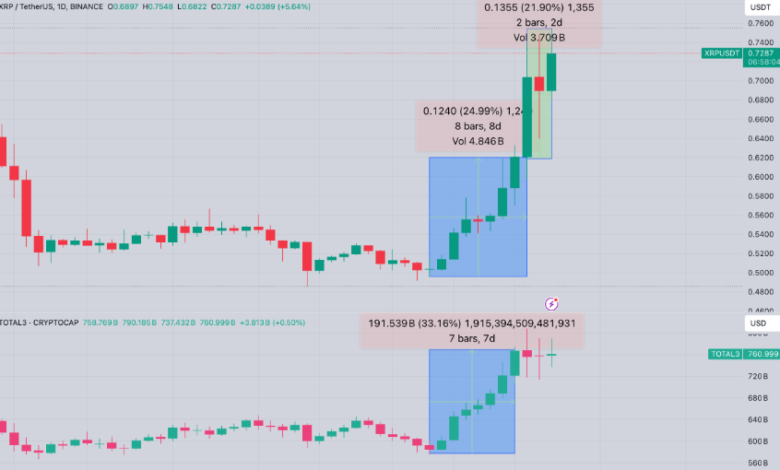What Are the Best Strategies for Trading XRP Based on Its Price USD?

XRP (Ripple) is one of the most widely traded cryptocurrencies globally. Known for its quick transaction times and low fees, XRP has become a go-to for investors and traders looking to diversify their portfolios. But to be successful in trading XRP, understanding its price movements and the strategies behind trading XRP based on its price in USD is crucial. In this article, we will explore the best strategies to trade XRP effectively, along with how to analyze its price fluctuations using the xrp price usdt.
Understanding XRP and Its Price in USD
Before diving into trading strategies, it’s essential to understand what XRP is and how its price works. XRP is the native token of the Ripple network, which aims to offer fast, low-cost cross-border payments for financial institutions. XRP’s price in USD fluctuates based on market conditions, investor sentiment, technological developments, and macroeconomic factors affecting the crypto market.
The XRP price USDT is often used by traders to understand XRP’s value against the US Dollar through the USDT (Tether) trading pair. Tether is a stablecoin that mirrors the value of the USD, allowing for a more accurate analysis of XRP’s price movements without the volatility associated with traditional cryptocurrencies.
Key Factors Affecting XRP’s Price Movements
To trade XRP profitably, it’s important to recognize the factors that influence its price. Some of the key elements include:
1. Market Sentiment and News
Cryptocurrency markets are highly sensitive to news. Positive or negative news regarding Ripple’s partnerships, legal battles, or technological developments can cause significant price movements. For example, any updates regarding Ripple’s lawsuit with the U.S. Securities and Exchange Commission (SEC) have caused large price swings in XRP.
2. Market Liquidity
XRP’s liquidity is an important factor that affects its price. High liquidity means that XRP can be bought or sold in large quantities without causing significant price changes. On the other hand, lower liquidity can lead to more volatility, making price prediction more difficult.
3. Regulatory News
Regulatory developments play a major role in the price of XRP. For example, if the SEC or any other regulatory body makes announcements that favor or restrict Ripple, it could influence the price of XRP in USD.
4. Bitcoin’s Price Movements
Bitcoin (BTC) is the largest and most influential cryptocurrency. XRP often correlates with Bitcoin’s price movements. When Bitcoin rallies or crashes, many altcoins, including XRP, tend to follow suit. Traders often monitor Bitcoin’s price to predict movements in XRP.
Best Strategies for Trading XRP Based on Its Price USD
Now that you understand what influences XRP’s price, let’s dive into the best trading strategies that can help you capitalize on these fluctuations in its USD value.
1. Trend Following Strategy
Trend following is one of the most popular strategies for trading XRP. This strategy involves identifying the overall direction of the market (whether the price is trending up or down) and taking positions that align with the trend.
How to Implement It:
- Identify the Trend: Use technical analysis tools like moving averages (MA) and relative strength index (RSI) to spot the prevailing trend. For example, if XRP’s price is consistently above the 50-day moving average, it’s considered to be in an uptrend.
- Trade with the Trend: Once you’ve identified the trend, consider entering long positions when the price is rising and short positions when it’s falling.
2. Breakout Trading
Breakout trading involves entering a position when the price breaks through key support or resistance levels. Breakouts often signal the start of a strong trend, making them an ideal opportunity for traders.
How to Implement It:
- Identify Key Levels: Look for well-established support and resistance levels on the XRP price chart. These levels are typically formed after multiple price touches and often act as barriers that price struggles to break through.
- Wait for the Breakout: Once the price breaks above resistance or below support, it’s a signal that the price may move significantly in the direction of the breakout.
- Enter the Trade: After the breakout, enter the trade in the direction of the breakout. For example, if the price of XRP breaks above a key resistance level, consider buying XRP in anticipation of further gains.
3. Swing Trading
Swing trading focuses on capturing short- to medium-term price moves within a trend. This strategy works well for XRP because of its frequent price fluctuations.
How to Implement It:
- Use Technical Indicators: Swing traders rely on technical indicators like the MACD (Moving Average Convergence Divergence) and RSI to identify overbought or oversold conditions.
- Wait for Pullbacks: After a strong price movement in either direction, wait for a pullback (a small price decline) before entering the trade. This allows you to buy XRP at a lower price during an uptrend or sell at a higher price during a downtrend.
4. Scalping
Scalping is a short-term trading strategy that aims to make small profits from tiny price movements. While this strategy requires significant attention and quick decision-making, it can be effective when trading XRP due to its volatility.
How to Implement It:
- Trade During High Volume Periods: Scalpers need high liquidity and volatility to make multiple trades in a short amount of time. Trading during high-volume periods, such as when major news breaks or during peak market hours, is ideal.
- Monitor Small Price Movements: Look for small price fluctuations of a few cents or less. Buy XRP when the price drops and sell when it increases by a similar amount.
5. Position Trading
Position trading is a longer-term strategy where traders hold their positions for weeks or months, relying on fundamental analysis rather than technical indicators.
How to Implement It:
- Analyze the Long-Term Trends: Position traders need to stay informed on Ripple’s developments and the overall market conditions. Long-term price movements can be influenced by events like regulatory decisions or the implementation of new Ripple technology.
- Buy and Hold: Once you’ve established a bullish outlook for XRP, you can buy and hold your position for an extended period, waiting for larger price gains.
Risk Management in XRP Trading
Regardless of which strategy you choose, effective risk management is crucial to protect your capital. Some risk management techniques include:
1. Stop-Loss Orders
A stop-loss order automatically closes your position if the price moves against you by a certain amount. This limits your losses and helps to protect your account from significant downturns in the market.
2. Proper Position Sizing
Don’t risk too much of your capital on any single trade. Position sizing refers to determining how much capital to allocate to each trade based on the overall size of your portfolio and risk tolerance.
3. Diversification
While trading XRP can be profitable, it’s important not to concentrate your portfolio too much in a single asset. Consider diversifying your investments across various cryptocurrencies or other asset classes to minimize risk.
Frequently Asked Questions (FAQs)
1. What is the best time to trade XRP?
The best time to trade XRP is during periods of high liquidity and volatility. This typically occurs during market open times or when major news events affect the cryptocurrency markets.
2. Should I trade XRP in USD or USDT?
Both USD and USDT can be useful for trading XRP. USDT provides more stability, as it’s pegged to the dollar, while trading against USD can be more volatile but may offer better insights into the market’s true price movements.
3. Can I predict XRP’s price with technical analysis?
Technical analysis can help you identify trends and potential entry or exit points, but it cannot guarantee price movement. Always combine technical analysis with other strategies, like fundamental analysis, for a well-rounded approach.
4. Is XRP a good investment for long-term holding?
XRP has shown potential for long-term growth due to its strong use case in the financial sector. However, as with all cryptocurrencies, it carries risks, especially regarding regulatory uncertainties.
5. How volatile is XRP compared to Bitcoin?
XRP is generally less volatile than Bitcoin, but it can still experience significant price swings due to market sentiment, regulatory news, and large investor movements.
6. How much capital do I need to start trading XRP?
The amount of capital needed to start trading XRP depends on your risk tolerance and trading style. For beginners, it’s recommended to start with a small amount and gradually increase as you gain experience.
Conclusion
Trading XRP based on its price in USD requires a combination of strategies, technical analysis, and risk management techniques. Whether you’re a trend follower, a breakout trader, or a swing trader, understanding the factors that influence XRP’s price is essential for success. By staying informed, using proper risk management, and implementing the right trading strategies, you can maximize your potential for profitability in the exciting world of XRP trading.




